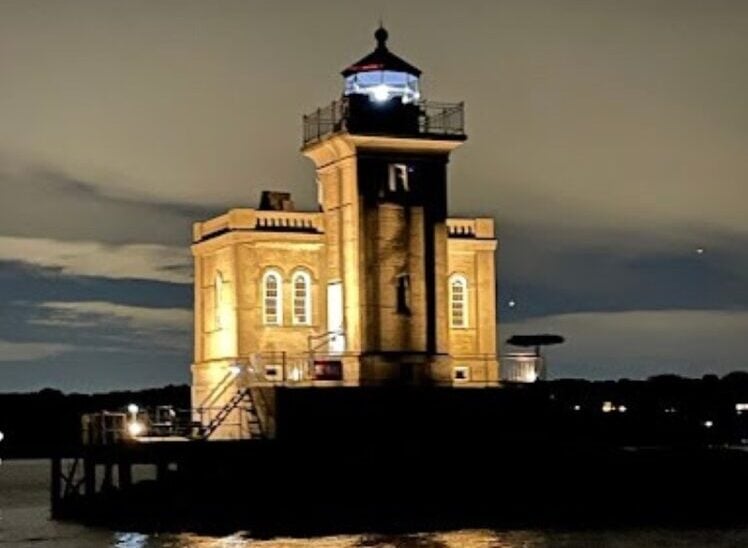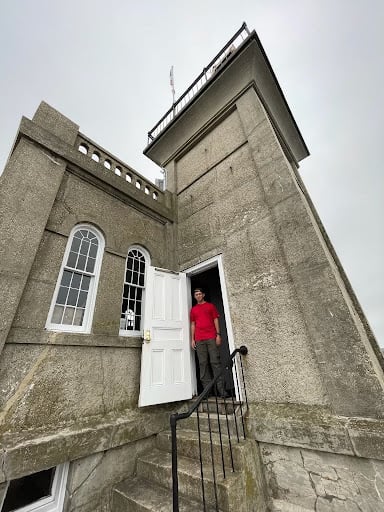His nickname was the “lighthouse kid” because of the many times he visited his favorite landmark in Huntington as a child. The name stuck and he eventually put it to good use.
When Huntington resident Ronnie Carrillo wanted to give back to a place that has given him so much joy, he thought of it immediately when he needed to come up with a project to achieve his Eagle Scout status. The Huntington Lighthouse Preservation Society was the first to receive a call.
They told Carrillo that they would love some uplighting around the lighthouse, a tall order for a then 14-year-old. He was intimidated by the task, but took up the challenge.
“I was really excited. I didn’t want to say no, because I was so happy to have a project,” Carrillo said. “I didn’t realize the huge undertaking that this project was, I really had to start from scratch.”
Though the project seemed difficult, it did pique his interest. After receiving his first merit badge as a scout in sixth grade, he fell in love with engineering and decided it was something that he wanted to pursue further. The lighting project was right up his alley and would give him some very valuable experience.
The first of Carrillo’s many tasks was to create a proposal, detailing what he wanted to do and how it would benefit the community. There was some pushback against the proposal since there are rarely any Eagle Scout projects done on the water, but it eventually was approved.
After the proposal was passed, the planning phase ensued. Carrillo had to plan out every intricate detail of the project, leaving no stone left unturned by the end of it. During that process, he spoke with two electricians from his church as well as a retired engineer from the Preservation Society, Oliver Bodine.
Bodine was the one that spearheaded the project, helping Carrillo with the planning and leading in the actual building process of the lighting.
Carrillo “did an extraordinary job of managing his people and organizing all of the details regarding the installation at the lighthouse,” Bodine said. “Without knowing very much about electrical components, he pulled it all together. I give him a great deal of credit.”
Thanks to the knowledge that Bodine contributed to the project, the planning process was made much easier for Carrillo. He had somebody that could make his vision possible, something that would not have been likely if it were not for him.
“I probably never would have been able to do it without him,” Carrillo said. “He was showing me things, I was showing him things, it was a great parallel dynamic we had going. His wisdom is something that I certainly won’t have for a long time. I can’t say enough, he really made the project possible.”
Starting in February of 2021, the proposal and the planning of the project took more than a year. The goal was to start the building process in the summer of 2022, but the details were not ironed out until late in the season. Facing a deadline due to the incoming winter and the stoppage of visitation to the lighthouse, everybody involved in the project had to move quickly.
It was beginning to look as though the project would not be ready by the deadline, but Carrillo kept pushing for it. If the deadline was not met, the project would have to wait another whole year.
Unfortunately, schedule conflicts on both sides resulted in the project being postponed until 2023. Though this was discouraging for Carrillo, it gave him more time to verify that every detail was perfect.
“I just finally had to accept that it wasn’t going to happen that summer, and that hurt a lot,” Carrillo said. “But what it did do was give me time to really double-check my planning. It was not the happiest feeling knowing that I had almost, in a way, missed a year of time. But at the same time, it really helped the overall results of the project.”
The team was ready to go once 2023 rolled around, but first they needed a way to fund the project. On Oct, 1, a car wash was held at Halesite Fire Department to raise money for the project. Carrillo had “20 to 30” fellow scouts help, one of whom donned an eagle costume to entertain their customers.
The fundraiser was a success, raising more than $1,800. The money was used to immediately purchase all of the necessary equipment for the lighting system, giving the team all the means to begin the building process.
“We went and installed all of the wiring and the electrical control panel, which I took responsibility for,” Oliver said. “ … and the Scouts did all of the outside wiring and mounted the lights. We switched it on and it worked right off the bat, so it was a very successful project.”
The team started building on Oct. 7 and it was expected to be about a three-day process. Thanks to Carrillo’s concise outline and Oliver’s experience, it only took a day and a half to complete.
The planning “took a long time, but it was probably so developed to the point where it was over-detailed, but it was perfect,” Carrillo said. “Once we got out there, there was nothing left to question. The project went super smoothly.”
Formerly, the lighthouse was not visible at night, making it difficult for boaters going in and out of Huntington Harbor to see where they were going. Now, the lighthouse stands with an illuminating glow at the top of it, thanks to Carrillo and his crew.
Carrillo has gotten feedback from multiple fishermen and motorists about his project, telling him about how much easier and safer it is for them now. Though he is pleased about the impact that he has made on his community, he is most proud of his ability to work in a team.
“In school projects and stuff, I tend to go at it alone,” Carrillo said. “For this project, I really couldn’t have that mindset, because I just didn’t know enough.” “The whole experience really taught me that other people’s advice could be really valuable. It’s something that’s going to stick with me forever now, it’s made a really positive impact.”
Carrillo, now 16, is a junior at St. Anthony’s High School in South Huntington.
He has not decided on a college yet, but he knows he wants to study engineering wherever he goes.
“The whole experience really taught me that other people’s advice could be really valuable. It’s something that’s going to stick with me forever now, it’s made a really positive impact,” he said.
Kenneth Spurrell is a reporter with The SBU Media Group, part of Stony Brook University’s School of Communication and Journalism’s Working Newsroom program for students and local media.



